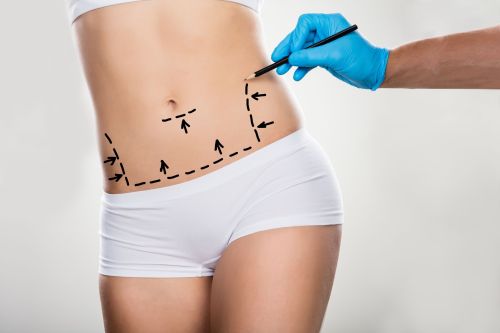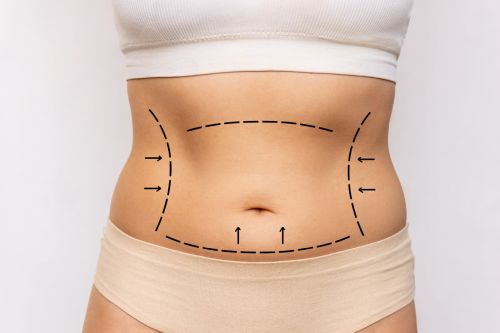An aesthetic operation where excess skin and fat in the abdominal area are removed, and muscles are tightened. It is preferred to tighten sagging abdominal skin after pregnancy or weight loss. With the surgery, a flatter and tighter abdominal appearance is achieved. Abdominoplasty is performed under general anesthesia, and the recovery process may take a few weeks. Abdominal aesthetics help to correct body contours.
In Which Situations is Abdominoplasty Performed?
 After pregnancy, abdominal muscles may loosen and the skin may lose its elasticity. This leads to sagging in the abdomen, and abdominoplasty is preferred to correct this excess skin and loosened muscles. After losing a large amount of weight, the skin can sag, leaving excess skin in the abdominal area. The operation removes this excess skin, providing a tighter appearance. Sagging in the abdominal area can be seen due to loss of skin elasticity with aging. In this case, surgery can also be a solution. Some people may have a genetic tendency for excess fat and sagging in the abdominal area. If this condition does not improve despite diet and exercise, abdominoplasty may be preferred. Abdominoplasty is an operation performed for both aesthetic and functional purposes. It can enhance a person's quality of life.
After pregnancy, abdominal muscles may loosen and the skin may lose its elasticity. This leads to sagging in the abdomen, and abdominoplasty is preferred to correct this excess skin and loosened muscles. After losing a large amount of weight, the skin can sag, leaving excess skin in the abdominal area. The operation removes this excess skin, providing a tighter appearance. Sagging in the abdominal area can be seen due to loss of skin elasticity with aging. In this case, surgery can also be a solution. Some people may have a genetic tendency for excess fat and sagging in the abdominal area. If this condition does not improve despite diet and exercise, abdominoplasty may be preferred. Abdominoplasty is an operation performed for both aesthetic and functional purposes. It can enhance a person's quality of life.
How is Abdominoplasty Performed?
 It is usually performed under general anesthesia. Thus, the patient sleeps during the operation and does not feel pain. The surgeon makes an incision in the lower abdomen, usually along the bikini line. This incision can be longer or shorter depending on the degree of sagging and excess. An incision can also be made around the navel. If the abdominal muscles are loose or separated, the surgeon tightens them by stitching them together again. This procedure provides a flatter and stronger abdominal structure. The surgeon removes the excess skin and fat in the lower abdomen. In some cases, liposuction (fat removal) may also be applied. The navel is repositioned and reshaped to achieve an aesthetic appearance. The surgeon carefully stitches the skin layers to close the incision. Scars from abdominoplasty usually become less noticeable over time. The patient enters a recovery period for a few weeks. Swelling and mild pain can be expected, and it is important to follow the care instructions provided by the doctor during this period. As a result, the surgery provides a flatter and tighter abdominal area. However, the recovery time may vary depending on the person and can take approximately 4-6 weeks.
It is usually performed under general anesthesia. Thus, the patient sleeps during the operation and does not feel pain. The surgeon makes an incision in the lower abdomen, usually along the bikini line. This incision can be longer or shorter depending on the degree of sagging and excess. An incision can also be made around the navel. If the abdominal muscles are loose or separated, the surgeon tightens them by stitching them together again. This procedure provides a flatter and stronger abdominal structure. The surgeon removes the excess skin and fat in the lower abdomen. In some cases, liposuction (fat removal) may also be applied. The navel is repositioned and reshaped to achieve an aesthetic appearance. The surgeon carefully stitches the skin layers to close the incision. Scars from abdominoplasty usually become less noticeable over time. The patient enters a recovery period for a few weeks. Swelling and mild pain can be expected, and it is important to follow the care instructions provided by the doctor during this period. As a result, the surgery provides a flatter and tighter abdominal area. However, the recovery time may vary depending on the person and can take approximately 4-6 weeks.
Precautions to Take After Abdominoplasty
 It is very important to rest and avoid heavy activities for the duration specified by the doctor. Heavy exercises and lifting activities are usually prohibited for 4-6 weeks. Bandages should be applied to the surgical area and a corset should be used as recommended by the doctor. This helps to reduce swelling and accelerate the recovery process. Care should be taken to clean the stitches and the surgical area. Dressings should be done according to the instructions provided to prevent the risk of infection. Pain may occur after abdominoplasty. Painkillers recommended by the doctor should be used, and the specified doses should not be exceeded. Switching to a balanced diet speeds up recovery. Drinking plenty of water helps to reduce swelling. During the recovery period, it is recommended to lie in a slightly bent position to avoid straining the abdominal area. This prevents the stitches from stretching and reduces discomfort. It is important to attend the follow-up appointments on time to monitor recovery. If signs of infection such as redness, swelling, foul-smelling discharge, or excessive pain are noticed, a doctor should be consulted immediately. These recommendations can help you get through the postoperative period in a healthier and smoother way.
It is very important to rest and avoid heavy activities for the duration specified by the doctor. Heavy exercises and lifting activities are usually prohibited for 4-6 weeks. Bandages should be applied to the surgical area and a corset should be used as recommended by the doctor. This helps to reduce swelling and accelerate the recovery process. Care should be taken to clean the stitches and the surgical area. Dressings should be done according to the instructions provided to prevent the risk of infection. Pain may occur after abdominoplasty. Painkillers recommended by the doctor should be used, and the specified doses should not be exceeded. Switching to a balanced diet speeds up recovery. Drinking plenty of water helps to reduce swelling. During the recovery period, it is recommended to lie in a slightly bent position to avoid straining the abdominal area. This prevents the stitches from stretching and reduces discomfort. It is important to attend the follow-up appointments on time to monitor recovery. If signs of infection such as redness, swelling, foul-smelling discharge, or excessive pain are noticed, a doctor should be consulted immediately. These recommendations can help you get through the postoperative period in a healthier and smoother way.


